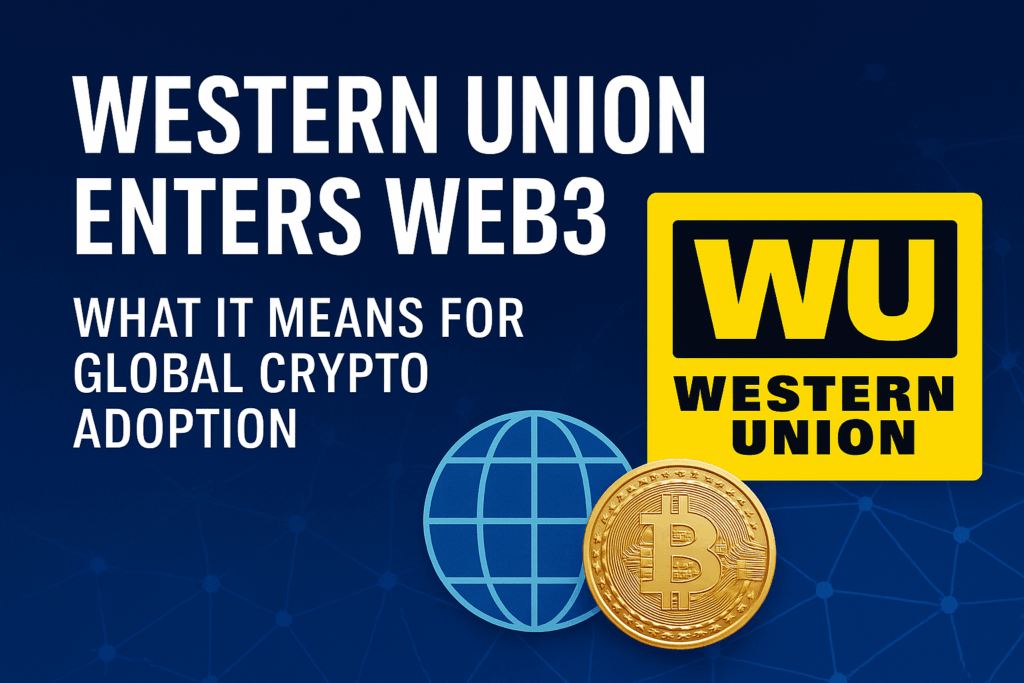Western Union, one of the world’s oldest and most trusted money transfer services, has officially entered the Web3 space. This move sends a strong signal across the financial world: blockchain technology is no longer an experimental concept. It now forms part of real-world infrastructure trusted by millions.
Western Union’s Web3 entry marks a turning point. When legacy players adopt blockchain, crypto enters the global mainstream faster.
What Western Union Actually Announced
Western Union recently partnered with blockchain platforms to support stablecoin-based remittances and crypto-to-cash services. The company will now enable users to send and receive funds using digital assets, such as USDC or USDT, with the option to cash out at thousands of physical locations worldwide.
This hybrid system combines Web3 rails with real-world access. It enables customers to experience fast, low-cost blockchain payments without requiring in-depth technical knowledge or a full digital wallet.
In short, Western Union will help onboard the next wave of users to crypto without forcing them to abandon cash or traditional finance.
Why This Move Matters for Global Adoption
Crypto faces two major challenges: accessibility and trust. Many people, particularly in developing countries, continue to rely on cash. Others hesitate to use blockchain due to unfamiliarity, volatility, or concerns about regulation.
Read Also: Top Crypto Listings to Watch in 2025: Don’t Miss These Opportunities…
Western Union already serves over 120 million customers in more than 200 countries. These users already trust the brand with their remittances and financial transactions. By integrating Web3, Western Union helps reduce fear and eliminates the steep learning curve that hinders crypto adoption.
This move opens the doors for billions of underbanked and unbanked users to access digital payments without entirely shifting into decentralized finance.
Web3 Meets the Physical World
One of the most exciting aspects of this integration is the connection between crypto and cash. Users can receive stablecoins and withdraw local currency through Western Union’s physical branches or agents. Likewise, they can deposit fiat and send funds as crypto across borders.
This system bridges the gap between decentralised finance (DeFi) and the real-world economy. It allows people in rural or underserved regions to participate in Web3 economies without needing a credit card, online bank account, or mobile crypto wallet.
For example, a user in the U.S. can send $100 USDC to their family in Ghana. The family can cash out the funds in local currency at a nearby Western Union agent, often faster and cheaper than using banks or mobile money.
Stablecoins Play a Central Role
Western Union’s Web3 integration relies heavily on stablecoins, especially USDC and USDT. These dollar-pegged digital assets offer the perfect balance between blockchain speed and currency stability.
Stablecoins eliminate price volatility and settle transactions on-chain in seconds. They give users confidence while avoiding long bank delays and excessive fees. More importantly, they enable international transfers without needing both parties to have traditional banking access.
This further strengthens the role of stablecoins as a core payment tool in the evolving cryptocurrency economy.
How Other Institutions Will Respond
Western Union’s entry into Web3 places pressure on other financial giants. Remittance competitors, such as MoneyGram and Wise, must now consider blockchain integrations to remain competitive. Banks may speed up their own token-based settlement systems.
The domino effect has already begun. Visa now settles some payments in USDC. PayPal released its own stablecoin. With Western Union joining this wave, Web3 adoption gains more institutional momentum.
As trust increases, global regulators may also accelerate guidelines for blockchain payments and stablecoin activity.
Final Thoughts
Western Union’s move into Web3 reshapes the conversation about crypto adoption. It proves that blockchain is not just for early adopters, traders, or developers. It now serves real users solving real problems.
By combining stablecoins with physical access and trusted infrastructure, Western Union bridges old finance with new technology. Billions now stand one step closer to experiencing the benefits of Web3.
This shift may mark the beginning of a global transition, where blockchain becomes part of everyday life — not just for tech insiders, but for everyone.
Damilola Ojoye
Oluwadamilola Ojoye is a seasoned crypto writer who brings clarity and perspective to the fast-changing world of digital assets. She covers everything from DeFi and AI x Web3 to emerging altcoins, translating complex ideas into stories that inform and engage. Her work reflects a commitment to helping readers stay ahead in one of the most dynamic industries today







